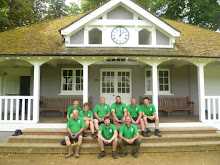 |
| Nuthatch |
 |
| Nuthatch |
In early December last year a bird song not heard in the gardens before was recorded and it is only now that the bird behind this song has been identified, a Nuthatch. For a few weeks this bird was seen and heard in the trees at the bottom of the Provost's garden, up high, it could not be seen enough to identify and the pattern of notes the bird was singing had not been heard before. The bird was eventually identified by a member of the BTO (British Trust For Ornithology) who knew the song as soon as they heard it. This Nuthatch has become the 53rd different species of bird recorded in the college grounds since the list began in 2007. (The Nuthatch photographs above are from online sources).
 |
| Goldcrest (Male, Orange Centre In A Yellow Crest Stripe) |
A bird seen easily in the gardens at the moment is the Goldcrest. The UK's smallest bird, they are regularly seen moving quickly in the fir trees looking for insects, rarely keeping still, this male, orange centre in a yellow crest stripe, was captured on camera by Ali.
 |
| Goldcrest |
Worcester College Bird List – 15th
January 2018
1.
Blue Tit
2.
Great Tit
3.
Coal Tit
4.
Blackbird
5.
Song Thrush
6.
Mistle Thrush
7.
Redwing
8.
Fieldfare
9.
Robin
10.
Sparrow
(Tree and House)
11.
Dunnock
12.
Long Tailed Tit
13.
Chaffinch
14.
Greenfinch
15.
Goldfinch
16.
Goldcrest
17.
Treecreeper
18.
Reed Warbler
19.
Blackcap
20.
Chiffchaff
21.
Wren
22.
Great Spotted Woodpecker
23.
Green Woodpecker
24.
Pied Wagtail
25.
Grey Wagtail
26.
Jay
27.
Kingfisher
28.
Magpie
29.
Goosander
30.
Mute Swan
31.
Mallard (inc Domestic Ducks, Muscovy, Crested
Duck)
32.
Grey Heron
33.
Canada Goose
34.
Greylag Goose
35.
Moorhen
36.
Coot
37.
Cormorant
38.
Wood Pigeon
39.
Collared Dove
40.
Jackdaw
41.
Crow
42.
Rook
43.
Starling
44.
Sparrowhawk (Nesting 2007-2009)
45.
Little Grebe (Spotted 2009)
46.
Rosybill Pochard (Escaped from captivity,
visited April 2012)
47.
Greylag Goose X Canada Goose (Visited March
2016)
48.
Grey Parrot (Escaped from captivity, visited
2009 )
49.
Parakeet (Spotted January 2012)
50.
Oystercatcher (Spotted Friday 4
th
August 9.00am on the sports field)
51.
Black-Headed Gull
52. Common Gull
53.
Nuthatch (6
th December 2017)
Update
54. Gadwall (26th January 2018)
55. Siskin (9th February 2018)







































